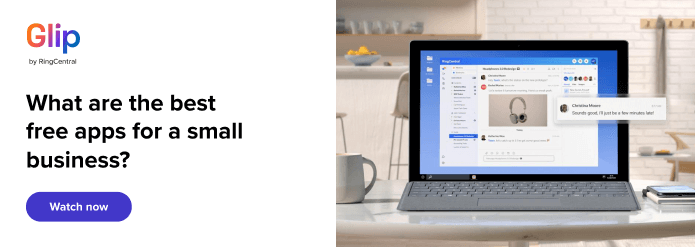Updated December 2020
If you’re looking for the best Slack alternatives for your business, you’ve come to the right blog.
With so much of the world going online today, a team messaging platform is essential to keep teams and employees connected—especially for remote workers and distributed teams.
A good instant messaging platform should allow you to instantly communicate with your team—both one-on-one and in groups. Other useful features you might find in popular instant messaging platforms include file sharing, screen sharing, the ability to search the message history, and even phone and video calls. And if the messaging tool is free? Well, that’s some truly delicious icing on the cake.
Which brings us to Slack. Launched in 2013, Slack is one of the most popular instant messaging platforms on the market today. When it first came out, there was nothing quite like it. Sure, other instant messaging platforms had been around for a long time (who remembers MSN?), but what Slack brought to the table was intuitive and functional design. And as a smaller company, Slack became known for its responsiveness to user needs and quick updates.
But just like most tech, Slack isn’t perfect for everyone. You might find it difficult to keep up on conversations or stay on top of the different channels created. And if you’re looking to have all of your video conferencing and messaging needs in one app, it’s a good idea to look at competitors. As of right now, Slack only allows one-on-one video calls, which could hamper face-to-face meetings with remote teams.
In this article, we’ll talk about the seven best alternatives to Slack on the market today:
🛒 In the market for a new team messaging tool? Find out how to find the right one with this free checklist.
The 7 best alternatives to Slack
1. Glip by RingCentral: Best overall features and value
RingCentral Glip is a unified communications platform that offers team chats, file sharing, and task management—all in the same app. Plus, Glip Pro is totally free!
Along with unlimited one-to-one and group messaging, Glip Pro comes with file sharing and task management capabilities. Task management is included in-app, making it easy to check up on who’s doing what. You can share and collaborate on files within the app, sparing you from having to switch between windows or email files back and forth. You can even invite external guests into the groups you create, for greater collaboration with your stakeholders.
There’s also a team calendar available so you can assign tasks and create events that are visible to different teams:
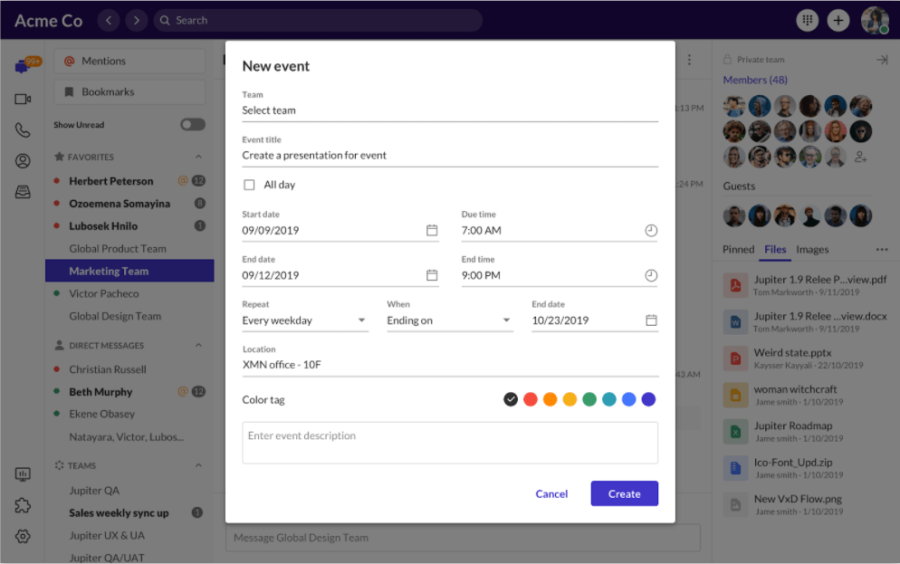
At the Pro+ level (the paid tier), Glip integrates seamlessly with Outlook and Google calendars. That means you’re automatically marked as “Busy” during meetings, with the option to turn on Do Not Disturb to silence chats that come through. (Trust us: this comes in handy if you’re sharing your screen in an important meeting!)
Besides all the team collaboration and messaging, RingCentral Glip includes high-def video conferencing at the free and paid levels—one-on-one and for teams (up to 100 participants on the free plan!). There’s even text chat available in any video call, so you can drop questions for presenters that they can read on the fly.
And of course, Glip Pro is totally free and easy to start using on both desktop and mobile. But if you are looking for more advanced features like Single Sign-on (SSO), APIs, and analytics, you can upgrade to Glip Pro+.
The verdict:
Glip Pro has the most complete feature capabilities out of any free app on this list, making it an excellent choice for small businesses. Between the unlimited users and chats, powerful video conferencing, task management, team calendar, and file sharing, it’s hard to find a better all-in-one free app than this one.

2. Chanty: Organized for easy collaboration
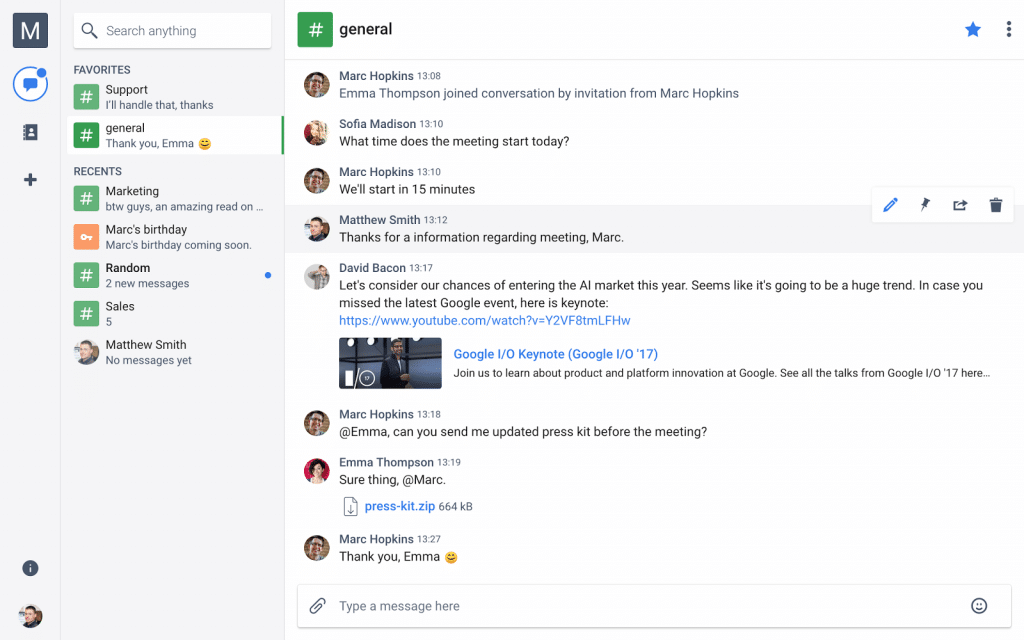
Chanty prides itself on being simple, powerful, and AI-powered. Along with traditional chat functions, Chanty offers users an easy onboarding process, an unlimited searchable message history, message pinning, and file sharing. Chanty also has audio and video conferencing, as well as the ability to record and send voice messages. An especially cool feature is called Teambook, where all of your files, tasks, and messages are sorted into folders.
3. Google Chat: Good for Gmail users
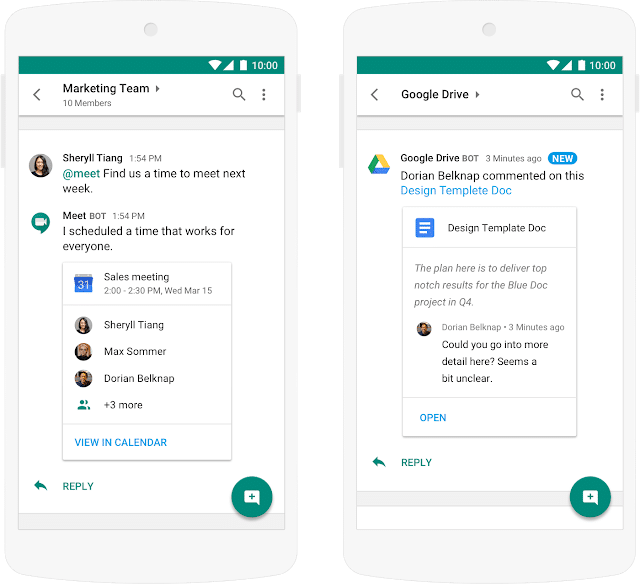
Google Chat is a newer addition to the Google Workspace lineup. As a Google platform, it comes already integrated with Workspace. As such, it’s a great option for teams that are already using Google Workspace. Group conversations are organized into Rooms, which are automatically private unless other users are invited, and can hold up to 8,000 users.
Google Chat has some pretty unique features, including Smart Replies, which—just like Gmail—automatically gives you suggested responses (perfect for users that are a little shy and not great at responding!) You also get a Do Not Disturb mode and the ability to view files stored in your Google Drive or Google Docs directly in Chat. Google Chat is also available in a whopping 28 languages.
Google Chat is also one of the most secure instant messaging platforms available, with enterprise-grade security and features like two-factor authentication, admin settings, mobile device management, and Single Sign-on.
4. Fleep: Good for external collaboration

Fleep is unique in the world of instant messaging software because it’s an open network. Users can invite anyone with an email address to secure chats and meetings. This makes Fleep a great option for teams that work closely and frequently with third parties, such as suppliers, contractors, and freelancers.
Another cool feature is email integration. Fleep can integrate emails with its chat system, so users can stay up to date and tuned in. Fleep also integrates well with Dropbox, Google Docs, and OneNote. Other useful features include file sharing, productivity tools, project management, and pinning messages.
5. Flock: Good for international companies
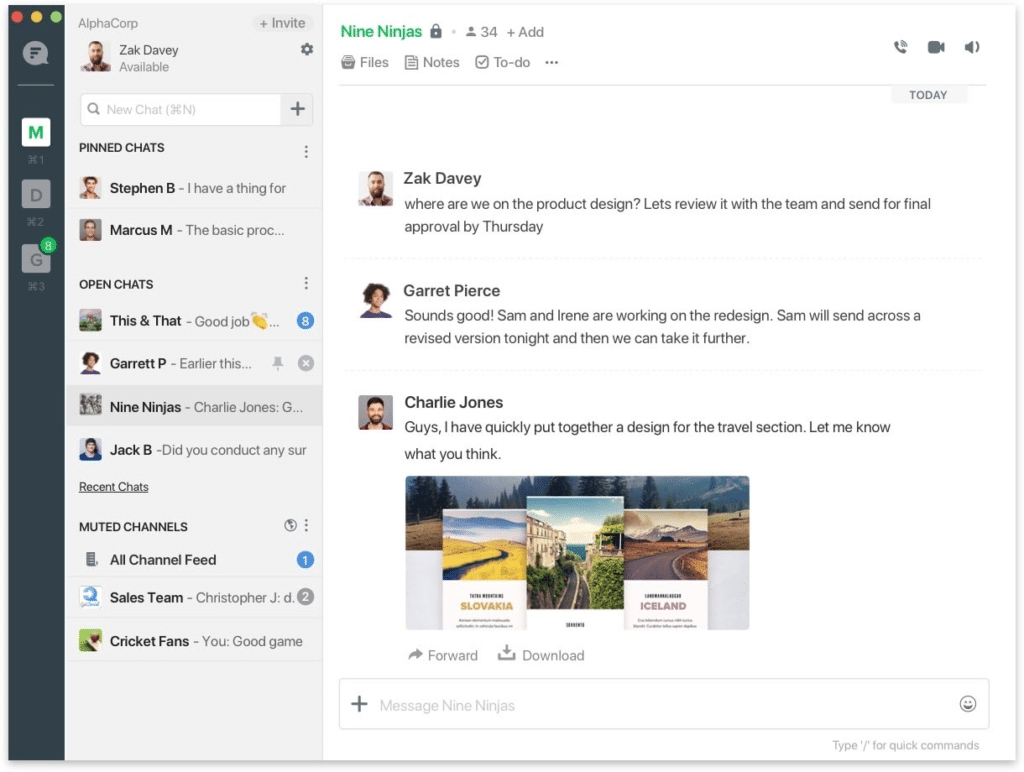
Flock has actually been around for as long as Slack and is available in several languages including Spanish, French, and Portuguese, which is a nice feature for international companies. Flock has an attractive user interface, is lightning-fast, and can integrate with more than 50 apps.
Flock also has some pretty cool and functional features. Users can share screens, make polls and to-do lists, and turn messages into tasks and assign due dates. There are also guest accounts and one-way announcement channels.
6. Rocket.Chat: Highly customizable
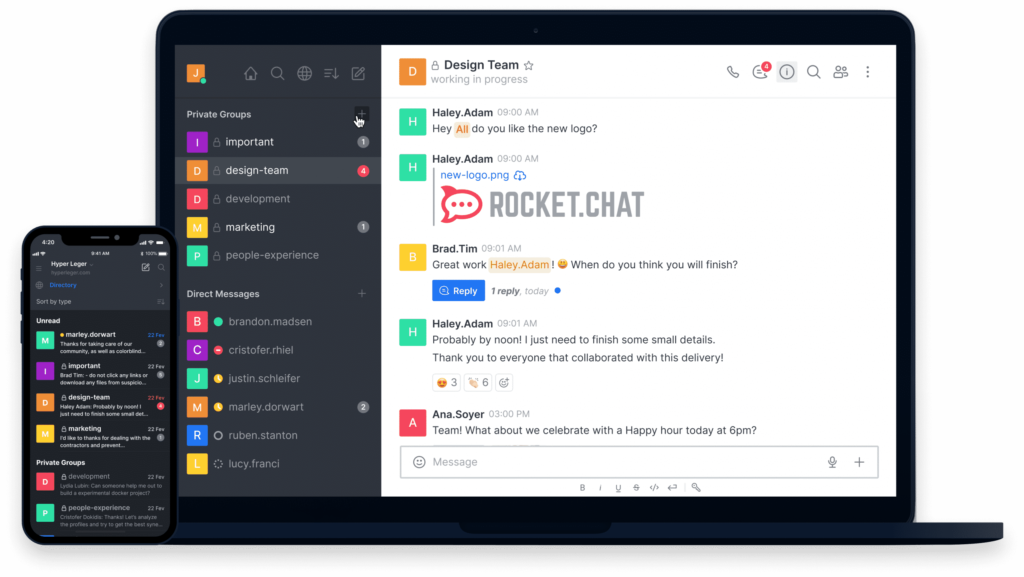
Rocket.Chat is an open-source app, meaning the platform can be fully customized to fit your team’s needs—provided you’ve got the developer know-how. However, Rocket.Chat isn’t just for DevOps and techies! In fact, it’s super easy to migrate to if you’re coming from Slack. The team chat is cloud based and kept secure with end-to-end encryption.
Because it’s so customizable, Rocket.Chat can also be configured into a CRM by creating helpdesks for your clients, answering queries, and converting leads. Rocket.Chat also has a real-time translation (with over 50 languages!)
7. Discord: Not just for gamers

Discord isn’t just for gamers! While yes, it’s very popular with gamers, it has an interface and features that will work for smaller teams that don’t need all the bells and whistles that come with other platforms.
Channels are divided by text and voice, and users can easily switch between private and public channels. Some unique features include push-to-talk and Instant Invite link, so users can share a chat server with anyone.
And, once your work day is done, you can stay on Discord and connect with gamers (if you’re into that).
What’s the best alternative to Slack?
There’s a wide world of instant messaging platforms like Slack, and it’s easy to get overwhelmed by all of the options. That’s why we’ve picked out some of the best alternatives to Slack. And, you may have noticed, most of them are free with the option to upgrade for more features and capabilities.
Pardon our bias, but we think Glip by RingCentral is the most powerful platform of the bunch. You get high-def video conferencing in addition to an extensive suite of collaboration tools, free of charge. It’s a great way to keep your whole team on the same page, no matter where they work.
Whether you’ve tried Slack and need a more all-in-one team communication solution, or you’re still looking for that first business messaging platform, there are lots of options to stay connected, productive, and up to date. Our advice: take advantage of free platforms and trial periods to find the best solution for you and your team.
Originally published Dec 15, 2020, updated May 29, 2024



